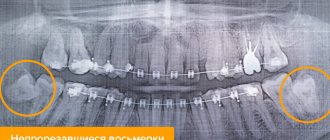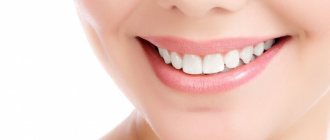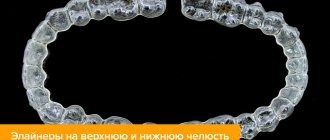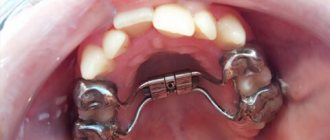Problem: a woman came to Family Dental on the advice of friends - she was looking for a clinic where she could restore two missing teeth in her upper jaw. During the diagnosis, the congenital absence of several teeth (primary adentia) and the long-term absence of one of the upper teeth due to extraction (secondary adentia) were discovered. The absence of teeth caused displacement of neighboring teeth and malocclusion.
Solution: the bite was corrected using Damon braces (the normal closure of the upper and lower teeth was restored), a place was prepared for prosthetics of the two upper teeth, 2 Astra Tech dental implants were installed, 13 teeth were replaced with ceramic crowns (E.max ceramics and zirconium dioxide).
Consultation, diagnosis and development of a comprehensive treatment plan
The woman had her central front tooth removed in another clinic because the tooth had decayed. At that time, she was not ready to install a dental implant, so the tooth was covered with a suspended structure to restore minimal aesthetics:
On the upper left there is no one more tooth (long ago removed due to destruction), and there is a gap between the teeth.
After some time, the woman began to look for a clinic where she could have two teeth restored with implants so that it would be beautiful. On the advice of friends, she turned to the Family Dentistry to orthopedic dentist A.S. Ivankov.
At the consultation, it turned out that, apart from the two removed teeth, there were no fifth teeth from birth (primary adentia), that is, there were milk teeth, but the permanent teeth did not grow during the change of teeth. Since this was a long time ago, the remaining teeth have shifted, and the missing teeth have closed almost completely. Due to the displacement of the teeth, the bite is disturbed, and in some places the upper teeth overlap the lower teeth (crossbite). An incorrect bite causes overload of certain groups of teeth, so there are areas of receding gums (gingival recession) in the area of the lower front teeth.
The orthopedic dentist advised us to start preparing for prosthetics by correcting the bite. Once the correct closure of the teeth has been restored and the place for prosthetic replacement of the two upper teeth has been prepared, it will be possible to install dental implants and crowns on implants. In a correct bite there will be no overload zones, implants and crowns will last longer.
The patient consulted orthodontist M.P. Sleptsova, calculations were made using dental casts and x-rays (panoramic, TRG in lateral projection). The patient also visited an osteopath, who at Dial-Dent always takes part in the diagnosis and treatment of orthodontic patients, since all changes in the position of the teeth affect posture, the functioning of the muscles and joints of the head and neck, and the functioning of the body as a whole.
The treatment plan was drawn up at a joint consultation of an orthopedic dentist and an orthodontist - the main specialists in this treatment. The patient’s desire was this: to make it beautiful and functional, but there is no need for perfect aesthetics, it’s better to have fewer interventions. Since the 5th teeth are missing evenly in all segments, and the gaps from them are almost completely closed, it was decided not to expand the teeth in these places, but, on the contrary, to move them, finally closing the gaps between the teeth, and create even dentition. The chewing teeth are worn down and destroyed by caries, the bite needs to be made higher, so after treatment with braces, the missing height of the teeth will be restored by dental crowns.
Treatment plan:
- Hygienic preparation for complex treatment.
- Re-treatment of the canals of one upper chewing tooth with a microscope, replacement of the old pin in the tooth with a new one made of fiberglass (since there will be a ceramic crown), treatment of dental caries.
- Orthodontic treatment – expansion of the upper dentition and restoration of normal closure of the teeth, preparation of a site for the installation of 2 dental implants in the area of the central and fourth tooth on the upper jaw on the left with displacement of the canine to the center, closing the gaps between the teeth on the lower jaw.
- Osteopathic correction throughout the entire orthodontic treatment.
- Installation of two Astra Tech dental implants.
- Dental prosthetics with ceramics (on implants and three front upper teeth with ceramic crowns made of E.max ceramics, and on chewing teeth with crowns made of zirconium dioxide).
The issue of eliminating gum recession (transplanting soft tissues into the recession zone) remained outside the treatment plan for now, since the patient did not want to increase the scope of surgery. It was decided to monitor the gums after orthodontic treatment, since in this case the cause of recession is precisely the overload of groups of teeth due to malocclusion, and after eliminating the overload, the recession can stabilize.
The estimate for treatment described in detail all the stages, their sequence, duration, and the cost of treatment at each stage (payment in stages). Treatment according to a pre-compiled estimate is much more convenient for the patient - there are no unexpected unpleasant surprises, the final amount of expenses and the time required for treatment are clear.
Commentary by the chief physician of Dial-Dent, orthopedic dentist S.V. Tsukora: “Some try to save money by carrying out different stages of treatment in different clinics (one has a familiar therapist, and another offers a special offer to brush your teeth). With this approach, there is no guarantee for the entire treatment; you often have to redo someone else’s work because it is not consistent with the final result.
The right approach in difficult cases is to look for a clinic where a team of doctors works and the treatment is carried out thoughtfully, step by step! After completion of treatment, the clinic will be able to provide a guarantee for all work performed. The patient must also follow preventive measures after treatment - come for examination, have professional teeth cleaning. If all this is done in one clinic, then there will be no problems for many years.”
Is it possible to put braces on crowns?
Installation of orthodontic brackets on an artificial crown is also possible. Treatment of malocclusion occurs thanks to living roots under the prosthesis, capable of moving in the direction specified by the brace system.
But most likely you will have to give up wearing inconspicuous lingual or aesthetic ceramic models, opting for a metal structure. This is due to the better adhesion of a metal lock to the surface of an artificial crown in comparison with retention elements made of other materials.
You will also have to carefully care for the oral cavity until the correct bite is formed, protecting the braces from mechanical stress. It is worth giving up hard, sticky foods, taking care to maintain a reliable fixation of the system.
Attaching a bridge prosthesis to supporting teeth is also not a problem. The orthodontist may recommend temporarily removing the bridge and installing temporary crowns, or suggest sawing the prosthesis into several parts to protect it from destruction.
Correction of bite – treatment with braces
Treatment with braces lasted 2 years. Damon self-ligating braces were used for treatment. Ceramic braces were installed on the front teeth, which created greater comfort for the patient, since they are hardly noticeable on the teeth.
Due to crossbite in some areas, overbites were placed on the lower teeth at the beginning of treatment.
After achieving proper closure of the teeth, the onlays are removed without leaving any traces.
The patient visited the orthodontist every 1.5 months.
Osteopathic correction was carried out after almost every visit to the orthodontist. The osteopath relieves accumulated tension in the bones of the skull and masticatory muscles, which facilitates the movement of teeth and reduces pain after installing new equipment or replacing arches. Treatment by an osteopath helps stabilize the result of bite correction.
As a result of orthodontic treatment, the dentition is aligned and space is created for prosthetics of the two upper teeth.
To temporarily restore the aesthetics of a smile, the missing central tooth is hidden using a hinged structure.
Braces for missing teeth
A good specialist can develop an orthodontic treatment plan even in this situation - of course, if there are still supporting teeth in the oral cavity on which the braces can be attached. Otherwise, dental implantation will first need to be done while you sleep or under general anesthesia. True, the amount of possible orthodontic care in this case may not correspond to the patient’s wishes. For example, a doctor can correct the position of the front incisors, but will most likely refuse to eliminate the “gap” at the site of the extracted tooth. Such a complex procedure will take a lot of time and require significant effort, and its result, for objective reasons, may be unpredictable.
Installation of dental implants
Two Astra Tech dental implants (Sweden) were installed. These are reliable implants that have been installed at Dial-Dent for more than 15 years. Astra Tech implants perfectly into bones due to the quality, as well as modern materials and technologies used in their manufacture.
After 4 months it was possible to begin dental prosthetics.
Types of bracket systems
Today the following systems of four types of materials are used:
- Metal. The most common and affordable, and also the most durable. But there are also nuances: if we talk about aesthetics, then metal braces are not the most advantageous option, and some people are allergic to the presence of metal in the mouth.
- Plastic. This type of braces is also quite inexpensive, but they are less durable than stainless steel. An important nuance - plastic structures are quickly stained by coffee, tea, cigarettes, acquiring a yellowish tint. It is better not to choose them for lovers of these drinks or smokers.
- Ceramic. Such designs are selected exactly to match the color of the enamel, so they look aesthetically pleasing and do not spoil the smile, and the ceramics are very durable. But one of the disadvantages of ceramic braces is their high cost.
- Sapphire. They are made from artificially grown sapphire crystals and are recognized as the most beautiful. Single crystals are transparent and invisible on the teeth; moreover, they can be easily cut and given any desired shape. But this type of structure is also quite expensive.
- Lingual braces can be made from any of the listed materials. This is the name of the system that is attached to the inside of the teeth and is invisible to the eyes of others. Such braces are often used when installed on the front incisors while maintaining the aesthetics of the dentition.
Most often, metal dental braces are chosen for correction due to their reasonable cost and practicality. However, in some cases, for example, with the same allergies, it is necessary to consider another type of orthodontic structures.
Dental prosthetics with ceramics
After correcting the bite, the gum recession stopped, as the overload of the teeth was eliminated, the patient did not complain about tooth sensitivity, and did not want to have another operation for the sake of aesthetics, so a soft tissue transplant was not performed and the gum level was not changed. This is decided before dental prosthetics, since the shape of the dental crowns depends on the level of the gums.
At the first stage of prosthetics, wax modeling was performed - models of dental crowns were made from wax so that the patient could evaluate the type of restorations before preparing the teeth.
Temporary dental crowns are then made from the wax models. Temporary dentures help the patient get used to the new sensations of teeth closing and appearance. You can make adjustments at this stage to make permanent crowns more perfect. In addition, temporary crowns are needed so that the gums take the desired shape in the area of the implants, since there have been no teeth there for a long time, and the gums become smooth, but should look like an arch.
A few weeks later, when the gums had returned to normal shape, impressions were taken for permanent ceramic crowns.
Dental crowns were made in Dial-Dent’s own dental laboratory (teeth with crowns are marked on jaw models):
Prosthetics of the front teeth requires excellent aesthetics, so crowns for all front teeth are made of E.max ceramics (including implants). E.max ceramics make it possible to make very thin restorations characterized by the natural translucency of the enamel. To make teeth on implants look natural, the abutment (the base for the crown installed on the implant) is also made of ceramic. For chewing teeth, strength is more important, so the crowns for the chewing group are made of zirconium dioxide.
Features of bite correction with implants
The main obstacle to orthodontic treatment after implantation is that artificial roots form an integral whole with the bone and cannot move in it. Living teeth are held in their sockets by ligaments. Therefore, their positions are not rigid and movement is possible at any age. The length of such “steps” is hundredths of a millimeter, but gradually you can move the tooth to any position. However, if there is a stationary implant in its way, the task becomes almost impossible. In this case, it is often necessary to remove the titanium rod, which interferes with orthodontic treatment, and install it back after or during the process of bite correction.
Of course, another way out can be found in this case. For example, polish the enamel of dental units or reduce the size of a molar, turning it into a premolar. Such decisions are made by the dentist together with the patient. In this case, all individual features of the clinical picture are taken into account.
If the implant does not prevent the movement of tooth roots, but the crown installed on it violates the aesthetics of the aligned row, the problem is solved by an orthopedic surgeon. For example, you can replace a straight abutment with an inclined one and thus correct the vertical position of the crown.
Dial-Dent specialists who restored the beauty of your smile
- Orthopedic dentist A.S. Ivankov - treatment planning, coordination of specialists’ work, dental prosthetics with ceramic crowns.
- Orthodontist M.P. Sleptsova - treatment with braces, preparation for dental prosthetics.
- Implant surgeon V.P. Alaverdov – installation of dental implants.
- Osteopathic doctor V.V. Bystrov – osteopathic correction during the period of occlusion correction.
- Dentist-therapist T.I. Matienko – treatment of dental caries, treatment of canals with a microscope.
- Dental hygienist E. Smirnova – professional dental hygiene.
- Dental technician D.V. Wolf – making dental crowns from ceramics.
- Dental assistants – S. Shchelkova, A. Antoshkina, M. Erkimbekova.
See other examples of the work of Dial-Dent specialists here.
Make an appointment for a consultation by phone +7-499-110-18-04 or through the form on the website. You can ask questions about dental prosthetics to the chief doctor of the clinic, Sergei Vladimirovich Tsukor, at
Useful tips about dental implantation from an orthodontist
The most important recommendation to patients is to try to preserve their teeth for as long as possible. Don’t rush to remove them, strive to treat them, even if their lifespan after that is five to seven years. Your own teeth are always better than the highest quality and most beautiful crowns and implants.
If dental implants are being considered, it is helpful to review the following recommendations from your orthodontist:
- Do not delay installing an artificial root if necessary. Timely restoration of the integrity of the row will prevent loss of bone tissue in the area of the formed defect and stop the movement of neighboring units to the empty space.
- Listen to your specialist if he recommends not installing an implant in favor of moving the remaining molars. The orthodontist may suggest, for example, to move the “eight” to the place of the seventh unit, and it, in turn, should be directed towards the removed “six”. This technique is not used often, but sometimes it makes sense.
- Make sure that implantation and orthodontic treatment are carried out by the same team of specialists.
It is very important that the orthodontist and surgeon communicate with each other. We jointly developed a competent, well-thought-out treatment plan and followed it. This can only be done if implants and braces are installed in the same clinic, with preliminary treatment planning in which all specialists participate.
Alignment methods for adults
Teeth straightening without braces in adult patients is used only in cases of uncomplicated pathologies. For example, the use of aligners - transparent trays made of polymer materials - allows you to correct the unevenness of the incisors and the density of the dentition.
To correct and disguise smile defects in adults, use:
- aligners;
- veneers and lumineers;
- prosthetics;
- restoration with composite materials.
At the same time, a corrective effect without unpleasant consequences is provided only by the use of aligners, the cost of a course of treatment of which in some cases is significantly higher than the price of a braces system. But even high-quality mouthguards will not help straighten teeth without braces for adults with serious pathology.
Teeth straightening with aligners
Aligners
- These are orthodontic aligners made of transparent polymers. Elastic but resilient supports placed over the upper and lower jaws that apply gentle pressure to guide the teeth into the correct position.
Aligners for teeth straightening
Teeth straightening with aligners occurs gradually and includes regular replacement of linings with denser ones. Each mouthguard is made individually based on the patient's orthodontic impressions.
Duration of treatment
depends on the complexity of the pathology and the type of aligners used. On average, it is 8-12 months of continuous - at least 20 hours a day - wearing the pads. If the expected correction time exceeds 1 year, then it is recommended to resort to teeth straightening with braces, as a faster and more effective method.
Types of aligners.
The effectiveness of treatment and its cost depend on the correct choice of an orthodontic mouth guard. Different manufacturers use their own technologies for producing aligners, and not all of them meet modern requirements. Therefore, when choosing devices, follow your doctor’s recommendations and give preference to certified products that have been tested and have real patient reviews.
Let's look at the most popular brands of orthodontic aligners used in Russian clinics:
Aligner Manufacturers
- Invisalign
is a development of Aling Technology (USA), the most experienced aligner manufacturer in the world. The mouthguard is manufactured using high-tech ClinCheck Pro software, which allows you to accurately predict the final result of therapy. With the help of this company's product there is a high probability of correcting severe malocclusions. The cost of a course of treatment, which involves replacing the lining every two weeks, ranges from 168 thousand rubles. - OrthoSnap
is an American company that produces more affordable aligners. Mouthguards are made from our own materials using Dynamic Physical Model technology without the use of computer modeling. Effective against minor defects such as diastema, crooked teeth. They do not allow you to predict the result. The cost of treatment with OrthoSnap aligners starts from 100 thousand rubles. - Star Smile
is a Russian analogue of American designs, produced by a young company. Uses 3D modeling programs, but does not have high manufacturing technologies. The use of aligners from this manufacturer gives good, predictable results in correcting minor defects in the anterior teeth. Due to the reduction in delivery costs, the price of treatment is lower than when using foreign aligners (from 80 to 160 thousand rubles). - Avantis 3D
is another Russian brand. In the production of aligners, we also use computer modeling and 3D technologies. This is one of the most affordable methods of treating jaw pathologies; the cost of treatment starts from 40 thousand rubles. But these mouthguards are not capable of correcting severe disorders.
The feasibility of treating malocclusion with aligners is assessed by an orthodontist. After all, even expensive high-tech mouth guards will not give the expected result in correcting severe pathologies.
Advantages of aligners:
- the ability to remove for eating and dental care;
- invisibility on teeth;
- do not cause allergies;
- do not injure the soft tissues of the oral cavity.
The main positive quality of the onlays is the ability to carry out usual oral hygiene, which significantly reduces the risk of caries.
Transparent aligners are almost invisible on the teeth
Cons of aligners:
- ineffective for severe disorders;
- have high treatment costs;
- cause discomfort when eating in public places;
- long production;
- unreliable fixation.
As we can see, the main disadvantage of the devices is the inability to correct complicated anomalies.
Price.
It directly depends on the chosen brand of aligners. Thus, treatment with Russian-made mouthguards will cost 40 thousand rubles or more, and the cost of using American high-tech developments reaches 280 thousand.
Veneers
Veneers
- These are overlays for teeth made of composite materials or porcelain. Designed to hide aesthetic smile defects.
Veneers are thin plates that are fixed to the outer surface of the teeth. Service life up to 10 years.
Veneers are coverings for teeth
Overlay thickness up to 0.5 mm. To make it look inconspicuous, the enamel is ground down by 0.3–0.7 mm.
It is impossible to straighten teeth with veneers. They are used to mask pronounced defects: chips, cracks, different heights of teeth.
Pros:
- invisible, as they are matched to the color of the patient’s enamel;
- short adaptation period, cannot be felt on the teeth just a few hours after installation;
- quick fixation procedure, instant results.
Veneers are matched to the color of tooth enamel.
Veneers easily cope with their task - masking unpleasant features of teeth, but do not solve problems with bite.
Minuses:
- the method requires grinding down the enamel;
- the need to repeat the procedure every 10 years or less;
- expensive treatment.
Veneers are used to correct minor defects. Plates are not able to hide pronounced abnormalities in the position of the teeth.
Price.
Installing one record costs 20 thousand rubles and more. The cost depends on the materials used and the complexity of the work.
Lumineers
Lumineers
– these are overlays on teeth, similar to veneers, but unlike the former, they have thin walls (up to 0.2 mm). Due to this difference, fixing the plates does not require cutting down the enamel.
Lumineers are ultra-thin veneers.
Teeth straightening with lumineers is similar in functionality to veneers - they mask smile defects.
Differences between lumineers and veneers.
The fundamental difference is the thickness of the plates, which is at least 2 times smaller for lumineers. This factor allows you to install onlays without grinding down your teeth, making their appearance natural. Lumineers produced using high-tech methods have greater strength and a service life that is twice as long as veneers.
Pros:
- do not require traumatic dental treatment;
- are made individually in a short time;
- do not lose their appearance throughout the entire period of operation;
- do not change tooth sensitivity;
- no different from other teeth.
If for some reason during the period of use it becomes necessary to remove the lumineer, this can be done without harm to the teeth.
Minuses:
- high cost of the record;
- They are not installed on large or strongly protruding teeth.
Price
for the installation of one lumineer from 30 thousand rubles.
Do not forget that with the help of onlays only the correction of external defects is possible, and not the treatment of pathology.
Composite dental restoration
Composite restoration
– a relatively inexpensive way to correct external tooth defects, in which, like filling, irregularities, chips, and stains on the enamel are masked using photocomposite materials.
Restoration of teeth using composite materials
During the work, the doctor first grinds the teeth and applies restoration material, drying each layer with a special lamp with UV radiation. The final layer is tinted to match the natural shade and polished. This technology is called tooth augmentation.
Pros:
- low cost;
- quick effect;
- aesthetics;
- does not require getting used to.
With the help of restoration, you can quickly return a damaged tooth to its correct shape.
Minuses:
- grinding down the tooth and removing the nerve (in some cases);
- service life up to 5 years;
- fragility;
- instability to dyes.
Depulpation (removal of the nerve) is a significant disadvantage of this procedure, as the tooth loses strength. This leads to premature tooth decay.
Price.
This correction method is distinguished by its accessibility. The cost of the procedure for 1 tooth is from 2,000 rubles.
It is impossible to straighten the bite of teeth with a composite material; using this method, part of the bone tissue is removed from the tooth in one place and built up in another, thereby improving the appearance.
Prosthetics with crowns
Dental prosthetics with crowns
– a radical way to correct your bite, which can give you the perfect smile... But at what cost?!
An artificial prosthesis can eliminate almost any external manifestations of malocclusion: curvature of teeth, different heights, gaps. However, this process is accompanied by high traumatism, since before the installation of crowns the enamel is strongly worn down, individual teeth are depulped (the nerve is removed). It turns out that the original, incorrectly positioned teeth are replaced with an ideal, but artificial smile.
Dental prosthetics with crowns
Types of crowns:
- metal ones - inexpensive, installed on the back molars, do not require much grinding of the enamel;
- ceramic – look as natural as possible, but fragile;
- metal-ceramic - strong, matched to the color of the teeth, but thicker, require strong grinding of the enamel;
- plastic ones are cheap, but very fragile and need careful care.
Ceramic crowns for teeth
Alignment of teeth with crowns is used to eliminate external defects and partially correct the bite.
Pros:
- quick results;
- individual production;
- aesthetic appearance.
Despite the positive aspects, the disadvantages of using this method to correct the bite are less pleasant.
Minuses:
- high price;
- the prosthetic procedure is irreversible, the teeth are ground down once and for all;
- Depulpation may be required.
Price:
Making a crown for one tooth costs from 6 thousand rubles. Prosthetic restoration of the front part of the teeth with metal-ceramic crowns costs 100 thousand rubles and more.
To summarize, we can draw the following conclusion:
Safe correction of malocclusion without braces in adults is only possible with the use of aligners, which gently return teeth to their correct position. If correction with mouthguards is not possible, it is recommended to install a brace system as the least traumatic method that allows you to preserve healthy teeth without grinding down the enamel and removing nerves.
FREE COMPUTED TOMOGRAPHY AND ORTHODONT CONSULTATION
Kuznetsov Egor Andreevich
Dentist-orthodontist, member of the European Association of Orthodontists. Certified specialist in working with all types of braces and clear aligners.
Work experience - 13 years.
At the first consultation, you will be able to undergo a dental computed tomography scan, find out how long the treatment will take and what results await you. Together with an orthodontist, you will select the best option for a brace system, receive recommendations for correcting your bite and answers to all your questions.
Cost of treatment
| Name | Price, rub) |
| Metal self-ligating braces (USA) 1 jaw | from 60,000 ₽ |
| Ceramic self-ligating braces (USA) 1 jaw | from 75,000 ₽ |
| Lingual braces (USA) 1 jaw | from 220,000 ₽ |
| Activation of the bracket system 1 jaw | from 3,000 ₽ |
*Prices are for one jaw.
Partial braces
Orthodontists use this type of construction in cases where it is necessary to correct deficiencies in only one of the jaws or at the initial stage of complex treatment. Partial braces are used for minor malocclusions caused by the misalignment of one or two teeth. The system is optimal when it is necessary to correct local tooth curvature in one area of the dental row.
This design is installed on only one jaw, and this is a very convenient solution: a partial braces system is significantly cheaper in cost than a full-fledged one, and it also does not create inconvenience when chewing food. But to use it, a number of conditions must be met.
Braces and implantation
Do they put braces on implants? An orthodontic system cannot be installed directly onto an implant. Natural tooth roots have little mobility, which is ensured by the presence of a ligamentous apparatus. Their gradual displacement with the help of braces does not harm the body.
An implant is a fixed artificial root implanted in place of a removed unit. Mechanical displacement of the implant will lead to injury and inflammation of the surrounding tissues, as well as to its rejection and loss from the bone. Therefore, it is better to carry out implantation after removing the device that corrects the bite.
If there is an implant, and if the position of the teeth is slightly crooked, it is recommended to install veneers or use crowns to restore the smile.
Braces and implantation. Wearing braces and implants together – is it possible or not?
Content:
- Installing an implant while wearing braces
- Braces and implantation
- Is it possible to put braces after implantation?
Many patients in dental clinics require not only bite correction, but also restoration of lost teeth. Therefore, a natural question often arises: “Is it possible to install an implant during braces?” Orthodontics and implantation are combined techniques, but each clinical case is individual. Let's look at how to properly combine these two technologies.











